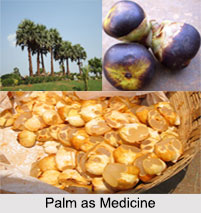 Borassus Flabelliformis is commonly known as "Palm" or "Palmyra". There are various uses of all parts of the Palm. The properties of various parts of this noble palm are described in detail in Sanskrit works. The root is cooling and restorative. The saccharine juice obtained by the excision of the young flowering branch, is when freshly drawn, cooling, sweet and useful in inflammatory affections and dropsy. The fermented juice called tari or toddy is intoxicating. The yellow pulp surrounding the seeds of the ripe fruit is sweet, heavy and indigestible. It is extracted by rubbing the seeds over a wooden scratcher, and with the addition of a little lime, it settles into a firm jelly which is a ready mode of taking the pulp. It is also made into cakes with flour and other ingredients. The young seeds contain a clear watery fluid which is very refreshing and cooling. They form one of the edible fruits of the country and are sold in the markets in large quantities when in season. The natives after extracting the pulp from the fibers surrounding the ripe seeds preserve them for some months. When the embryo begins to germinate and enlarge, the seeds are cut open and the expanded embryo is extracted and eaten. It is cooling, sweet and palatable. The terminal bud or top of the taal tree is regarded as nutritive, diuretic and tonic. The leaves of this palm tree were used for writing on by the ancient Hindus. The letters were engraved upon the leaves by a pointed iron instrument. This system of writing is still followed to a considerable extent in Odisha where boys in the indigenous pathshalas write with iron pens on palm leaves. In Bengal the leaves are written upon with pen and ink as on paper. The ashes of the flowering stalk are said to be useful in enlarged spleen.
Borassus Flabelliformis is commonly known as "Palm" or "Palmyra". There are various uses of all parts of the Palm. The properties of various parts of this noble palm are described in detail in Sanskrit works. The root is cooling and restorative. The saccharine juice obtained by the excision of the young flowering branch, is when freshly drawn, cooling, sweet and useful in inflammatory affections and dropsy. The fermented juice called tari or toddy is intoxicating. The yellow pulp surrounding the seeds of the ripe fruit is sweet, heavy and indigestible. It is extracted by rubbing the seeds over a wooden scratcher, and with the addition of a little lime, it settles into a firm jelly which is a ready mode of taking the pulp. It is also made into cakes with flour and other ingredients. The young seeds contain a clear watery fluid which is very refreshing and cooling. They form one of the edible fruits of the country and are sold in the markets in large quantities when in season. The natives after extracting the pulp from the fibers surrounding the ripe seeds preserve them for some months. When the embryo begins to germinate and enlarge, the seeds are cut open and the expanded embryo is extracted and eaten. It is cooling, sweet and palatable. The terminal bud or top of the taal tree is regarded as nutritive, diuretic and tonic. The leaves of this palm tree were used for writing on by the ancient Hindus. The letters were engraved upon the leaves by a pointed iron instrument. This system of writing is still followed to a considerable extent in Odisha where boys in the indigenous pathshalas write with iron pens on palm leaves. In Bengal the leaves are written upon with pen and ink as on paper. The ashes of the flowering stalk are said to be useful in enlarged spleen.
This article is a stub. You can enrich by adding more information to it. Send your Write Up to content@indianetzone.com
Related Articles
Ayurveda
Sushruta Samhita
Classification of Medicine
Properties of Material Objects and its Effect on Human Body




















